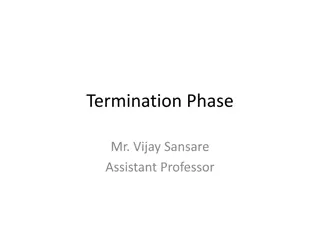
Understanding Probability Sampling Methods in Research
Learn about simple random sampling and systematic random sampling as two common probability sampling methods used in research. Explore the characteristics, advantages, and limitations of each method to make informed sampling decisions in your research projects.
Download Presentation

Please find below an Image/Link to download the presentation.
The content on the website is provided AS IS for your information and personal use only. It may not be sold, licensed, or shared on other websites without obtaining consent from the author. If you encounter any issues during the download, it is possible that the publisher has removed the file from their server.
You are allowed to download the files provided on this website for personal or commercial use, subject to the condition that they are used lawfully. All files are the property of their respective owners.
The content on the website is provided AS IS for your information and personal use only. It may not be sold, licensed, or shared on other websites without obtaining consent from the author.
E N D
Presentation Transcript
Simple random sampling As a sampling method, there is no grouping, queuing, etc. in the overall unit, completely excluding any subjective and purposeful choices, and adopting purely accidental methods to select samples from the mother. This method can better show that the chances of each child in the population are completely equal, and the selected sample is close to the characteristics of the population. It is a simple and easy method in various probability sampling. In order to achieve randomization of sampling, methods such as drawing lots and checking random value tables can be used. The advantage of this method is that the sampling error is small, but the disadvantage is that the sampling procedures are more complicated. In actual work, it is not easy to truly achieve the same chances for each individual in the population. 2
THE CHARACTERISTICS OF SIMPLE RANDOM SAMPLING It requires that the number of sampled population is limited, so that it is convenient to analyze the population through randomly drawn samples. It is extracted one by one from the overall. In this way, it is easy to operate in sampling practice. It is a kind of sampling without replacement. Sampling practice often uses non-replacement sampling, which makes it more widely practical, and because there are no individuals in the drawn sample that have been repeatedly drawn, it is convenient for related analysis and calculation. Every time it is selected, each individual in the population has the same possibility to be drawn, thus ensuring the fairness of this sampling method. 3
Systematic Random Sample No camera on computer so couldnt uplord facial expression video sorry about that ( `) Berial 2
CHARACTERISTICS OF SYSTEMATIC RANDOM SAMPLING System random sampling is also called mechanical random sampling. Its operation method is: first, arrange the number of each observation unit according to a certain sign order and divide it into equal groups, so that the number of groups is equal to the number of samples, and then extract objects from each group in order.
The advantages of systematic random sampling are: compared with simple random sampling, sampling error is smaller; compared with stratified random sampling, it is widely used in sampling survey. Limitations of systematic random sampling: when the sequence and sampling interval have the corresponding periodic, systematic sampling will lead to serious sampling errors. When a certain number of objects are selected, there may be several individuals left after grouping and division. In this case, a process of "elimination" is needed, that is, to extract and remove the unexpected individuals by simple random sampling.
stratified sampling Stratified sampling, also called type sampling.It is to divide the total unit into several types or layers according to its attribute characteristics, and then randomly select the sample units in the type or layer. The units of the population are first divided into several sub- populations (layers) according to certain characteristics, and then a sample is formed by simple random sampling from each layer. For example;A unit of a worker 500 people, including 125 less than 35, 280 men aged 35 to 49, 95 people over the age of 50. In order to understand this unit worker health related indicators, to extract a capacity of 100 samples, due to the worker age is associated with the index, decided to adopt stratified sampling method to extract. Because the number of sample size and the overall ratio of 1:5, so in all ages the number of extraction followed by 125/5280/5 remarks / 5, 25,56,19 namely.
CHARACTERISTICS OF STRATIFIED SAMPLING The characteristic of stratified sampling is that it is easy to extract representative survey samples due to the increased commonality among units in each type through stratification.This method is applicable to the situation where the overall situation is complex, the difference between units is large, and there are many units.
Cluster sampling refers to a sampling organization method which is used to conduct a comprehensive survey of selected groups. For example, when testing the quality of a particular part, it is not to pick the parts one by one, but to draw a number of boxes at random (each box contains several parts) to carry out a comprehensive inspection of the parts drawn. When the whole and the whole are divided into R groups with equal number of units, the r groups are extracted from the R groups for investigation by non-repetition sampling method. 11
APPLICATION & ADVANTAGES AND DISADVANTAGES The advantage of cluster sampling is that it is convenient to implement and saves money; the disadvantage is that the sampling error caused by cluster sampling is often larger than that of simple random sampling, and the distribution of samples is not wide, and the representative of samples to the population is relatively poor. When the difference between subgroups is small and the heterogeneity within each subgroup is large, it is especially suitable for cluster sampling. 12
THE STEPS OF CLUSTER SAMPLING Divide the population into discrete parts, each in groups. Criteria for determining subgroups 2 1 3 According to each sample size, determine the number of groups to be extracted. A simple random sampling or systematic sampling method is used to extract the determined number of groups from i groups. 4 13
summary 14
Their differences are: the basis of division is different the sampling method is different the scope of application is different.
Stratified sampling requires a large difference between different layers, with small individual or unit difference in the layer, while cluster sampling requires a small difference between groups, with large individual or unit difference in the group; stratified sampling samples are composed of several units or individuals from each layer, while cluster sampling is either cluster sampling or cluster sampling is not. 16
Thanks 17






















